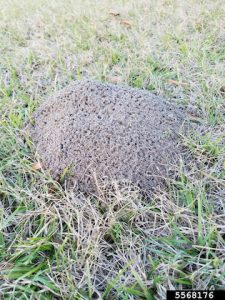It’s Fire Ant Season!
April 26, 2023By Bryan Smith, Clemson Extension Service
You have been battling the Red Imported Fire Ant unsuccessfully for a number of years now. Every time you knock out one mound it seems like three more pop up nearby, and if you stomp on the mound in frustration the ants have a painful little surprise in store for youe. Baits don’t seem to work and pesticides seem to kill only the mounds treated.
The problem is that we just don’t know how to apply fire ant products properly. We want to go in the yard, apply the insecticide or bait, and see those little critters die immediately. That intense satisfaction lasts for a few minutes until we get zapped by a fire ant from another mound nearby. Some products do offer this type of fast kill, but usually the kill is limited to the ants actually touched by the product and the queen stays happy down in her nest.
Fire ant baits can be quite effective if used properly. They are most effective when broadcast over the yard according to the label directions. Clemson Extension recommends the “two-step” method: (1) broadcast a fire ant bait at the recommended rate, then (2) two to four weeks later use a fire ant insecticide on any remaining active mounds. In order for this method to work, though, we have to understand the fire ant – and the baits.
First, fire ant baits must be applied when the ants are actively foraging. Fire ants actively forage only when the soil surface temperature is between 70 and 95 degrees Fahrenheit. If we apply a bait during mid-day or at night, we are missing the most active ant forage times – and severely limiting the effectiveness of the bait. The best approximate times to apply a bait during summer days are between 7:00 and 10:00 a.m. or between 5:00 and 8:00 p.m., but in the cooler spring you may be able to apply closer to mid-day. These are the times that the fire ants are most active and will take the bait back to the mound. A simple check will tell you when the fire ants are foraging – pour a small pile of potato chip crumbs on the ground in an area with fire (but not on a mound) and walk away. Check the crumb pile 20 minutes later. If the ants are working, most of the crumbs will be gone. You might like to place a rock near the pile of crumbs to mark the spot,because if the ants are really working, all of the crumbs will be gone!
Second, fire ant baits have a limited life span. Most fire ant baits are made up of a soy-based or corn-based granule with some tiny amount of insecticide added. The granule is quite attractive to the fire ant – at least while it smells good. The granule starts to degrade the minute it is exposed to air. Fire ants are 5,000 times more sensitive to odors than humans, so they can easily tell “good” food (fresh bait) from “spoiled” food (old bait or bait applied with fertilizer). Most baits have a life span of only 4 to 6 hours before the granule becomes rancid to the fire ant. So if we apply a bait at 1:00 p.m., there is little chance that much of it will be gathered by the ants before it turns rancid. The bait has a very tiny amount of insecticide on each granule, so we need to apply it at the right time so that the ants will take large amounts back to their mound.
Third, fire ants forage up to 100 feet (or more) from their mound. You do not have to apply a bait directly to a mound to control it. If the fire ants are foraging when you apply the bait, they will range far and wide to bring it back to the mound. This makes applications of baits relatively simple – just walk around the yard with little care if you cover every square inch with bait. In my own yard, I’ll make a pass across the lawn applying bait, move over about 20 feet (roughly 7 paces), and then make another pass until I apply the proper amount of bait for the size of the yard. The fire ants will find the bait
So here’s how to get the most out of your baits and make them work. First, use fresh bait from an unopened container. Second, make sure the ants are actively foraging before you apply the bait. Third, apply the bait at the labeled rate (usually 1 to 1.5 pounds per acre), criss-crossing the yard but not trying to cover every square foot of yard – remember, the fire ants forage extensively. Use a clean, hand-held fertilizer spreader (with the gate opening set at 1/8 inch) or buy a hand-held spreader just for the baits so that the fertilizer smell doesn’t get on them. Finally, treat any remaining active mounds two to four weeks later with a fire ant insecticide.
If you broadcast a bait using this method twice each year – once in late April or May and again in late July or early August – you will be amazed at the level of control. You will still have a mound or two once in a blue moon, but your fire ant pressure will be incredibly reduced. If you miss the April/May window you may still apply baits in the summer (paying attention to when the ants are foraging).
One final note – there are no fire ant baits labeled for use in a vegetable garden, although there are a few insecticides labeled for that use. The concern is that the insecticide or bait may be taken up by the plants. The good news is that if you apply the bait properly in your yard (but not in the garden), the vegetable garden fire ant problem will usually take care of itself as the ant pressure in the yard subsides and those ants in the garden forage more widely. Be safe – follow label directions of the product you choose and use it only where specified by the label. More fire ant information is available on the Clemson Home and Garden Information Center:
Home Lawn Fire Ant Control
https://hgic.clemson.edu/factsheet/fire-ant-management-in-the-home-lawn/
Home Garden Fire Ant Control
https://hgic.clemson.edu/factsheet/controlling-fire-ants-in-the-vegetable-garden/
The Clemson University Cooperative Extension Service offers its programs to people of all ages, regardless of race, color, gender, religion, national origin, disability, political beliefs, sexual orientation, gender identity, marital or family status and is an equal opportunity employer.
Image credit: Rebekah D. Wallace, University of Georgia, Bugwood.org
(https://www.forestryimages.org/browse/detail.cfm?imgnum=5568176)














